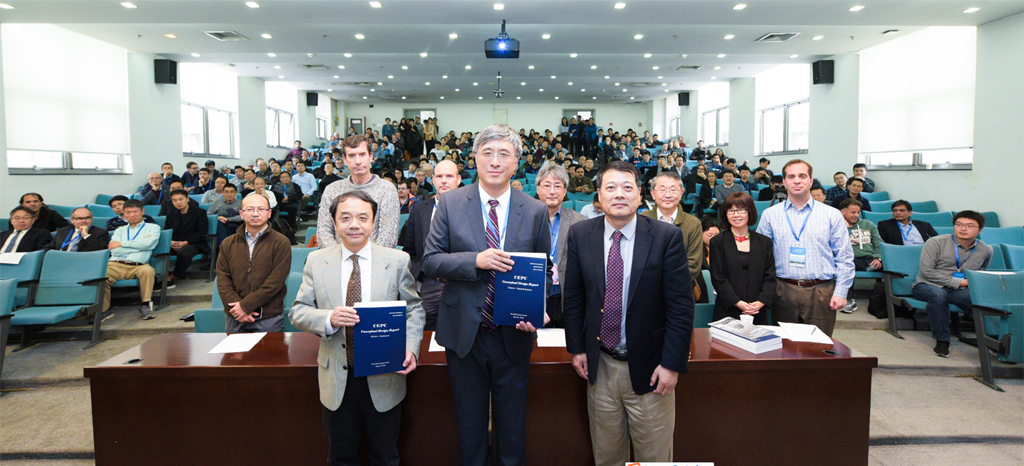The Conceptual Design Report of Circular Electron Positron Collider is Officially Released (2018-11-14)
On November 14th, the Circular Electron Positron Collider (CEPC) research group officially released the CEPC Conceptual Design Report (CDR), which are the “Conceptual Design Report -- accelerator Volume” and “Conceptual Design Report -- Detector and Physics Volume”. On the release ceremony, the Academician Yifang Fang, Director of the institute of high energy physics of the Chinese academy of sciences and Director of the CEPC steering committee, formally released the CEPC Conceptual Design Report on behalf of the CEPC research group.
In 2012, the Chinese physicists on high energy physics proposed the CEPC project and immediately launched the preliminary research of it. Only two years later, the CEPC "Preliminary Conceptual design Report (pre-CDR)" was released, which was then received the positive comments from the international review. After three years’ hard working, the CEPC design and pre-research team made an important progress that the Concept Design Report is formally completed and get the recognition from the international authoritative experts.
CEPC Conceptual Design Report contains two volumes, "accelerator volume" and "detector and physics volume", which respectively describe the scientific goal of the project and feasibility of the design of accelerator and detector. The report contains the research achievement by thousands of scientists over the past six years.
The CEPC CDR is widely praised and supported by the public.
"I kindly congratulate the important achievements on CEPC CDR. This is important milestone of CEPC, “Geoffrey Taylor, the professor of the University of Melbourne, the director of the International Future Accelerator Committee and Asia Accelerator Committee, said " there is no doubt that the international researchers of high energy physics wish to participate in the CEPC R&D and the future scientific experiment, this will greatly promote the further understanding of the basic of matter."
Barry Barish, the 2017 Nobel Prize Winner in physics and the professor of the California Institute of Technology (who led the discovery of gravitational waves on LIGO experiment), congratulated: "the history of accelerators is the realization of higher energies. The accelerator is the core tool for many important discoveries in particle physics for decades. CEPC will continue the great tradition! I kindly congratulate the outstanding work of CEPC research group.
Wei-Shu Hou, the professor at Taiwan University and director of the Asian High Energy Physics Committee, said "I appreciate the CEPC team for their effort on completing the CDR. The seriousness of this work has attracted more and more attention all over the world and laid a good foundation for the feasibility of the next Technical Design Report, engineering design and future construction schedule. I wish your hard work can realize a world-leading high energy physics large-scale scientific facility in the future.”
Academician Yifang Wang pointed that "The CEPC Conceptual Design Report is a major achievement. CEPC is an international science project. We believe that the international high energy physics community can work together to realize the construction of CEPC.
Professor Yuanning Gao, Director of CEPC Institutional Committee, professor of Peking University, said "The CDR marks the completion of the basic design of the accelerator, detector and civil engineering for the whole project, the next step is to focus on the development of key technologies and prototypes for CEPC. I hope we can get the positive response from the government in the future.
The “Conceptual Design Report -- Accelerator Volume” introduces the overall design of accelerator, including the linear accelerator, damping ring, intensifier and collider. In addition, a series of important supporting facilities such as cryogenic systems, civil engineering and radiation protection are introduced, and possible options for CEPC upgrade are discussed.
The “Conceptual Design Report -- Detector and Physics Volume” presents the physics potential of CEPC, introduces the design concept of detector and the key technical options, deeply evaluates the detector and physics of CEPC, and discusses the preliminary plan of detector R&D and physics research in the future.
Prior to CEPC construction, the pre-research of key technologies must be based on the Conceptual Design Report. The project team plans to build a series of key component prototypes in 2018 - 2022 to verify the feasibility of technologies and large-scale industrial processing. CEPC is expected to start the construction on the 14th “five-year plan” and be completed before 2030. CEPC's preliminary scheme is to study the Higgs boson at 240GeV for seven years, then study the Z boson and heavy flavor physics at 91 GeV for 2 years, and then study the W boson physics at 160GeV for one year. One of the possible future development options is to upgrade to a Super proton-proton Collider (SppC) with a central energy of 100TeV, which can directly find new physics on a large scale.
CEPC is an important part of the global high energy physics research program. CEPC can support the scientists from all over the world to research the high energy physics in depth. By the efforts and exploration of frontiers, the understanding of matter, energy and the fundamental nature of the universe will reach an unprecedented level.

|



